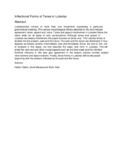| dc.contributor.author | Odera, Hellen | |
| dc.contributor.author | Barasa, David | |
| dc.contributor.author | Alati, Atichi | |
| dc.date.accessioned | 2021-12-31T08:56:23Z | |
| dc.date.available | 2021-12-31T08:56:23Z | |
| dc.date.issued | 2021-01-10 | |
| dc.identifier.uri | https://doi.org/10.32996/ijllt.2021.4.1.3 | |
| dc.identifier.uri | https://al-kindipublisher.com/index.php/ijllt/article/view/1203/984 | |
| dc.identifier.uri | http://ir-library.mmust.ac.ke:8080/xmlui/handle/123456789/1966 | |
| dc.description.abstract | Lutsotsoverbs consist of more than one morpheme expressing a particular grammatical meaning. The various morphological affixes attached to the verb indicate agreement, tense, aspect and voice. Tense and aspect morphemes in Lutsotso follow the same order for all types of verb constructions. Although tense and aspect in Lutsotso are deeply intertwined, this paper focuses on tense only. The Lutsotso tense is divided into the present, past and the future. The past and the future are distributed in four degrees as follows: remote, intermediate, near and immediate. Since the verb is the unit of analysis in this paper, we first describe the basic verb form in Lutsotso. This will entail the verb root and other crucial aspects such as the final vowel and the infinitive formthat influence it. We also give agreement in the feature, person, number, subject verb markers and object markers. Finally, tense forms in Lutsotso will be discussed beginning with the present, followed by the past and the future. | en_US |
| dc.language.iso | en | en_US |
| dc.publisher | InternationalJournal of Linguistics, Literature and Translation (IJLLT) | en_US |
| dc.subject | Inflectional,Forms,Tense,Lutsotso | en_US |
| dc.title | Inflectional Forms of Tense in Lutsotso. | en_US |
| dc.type | Article | en_US |

